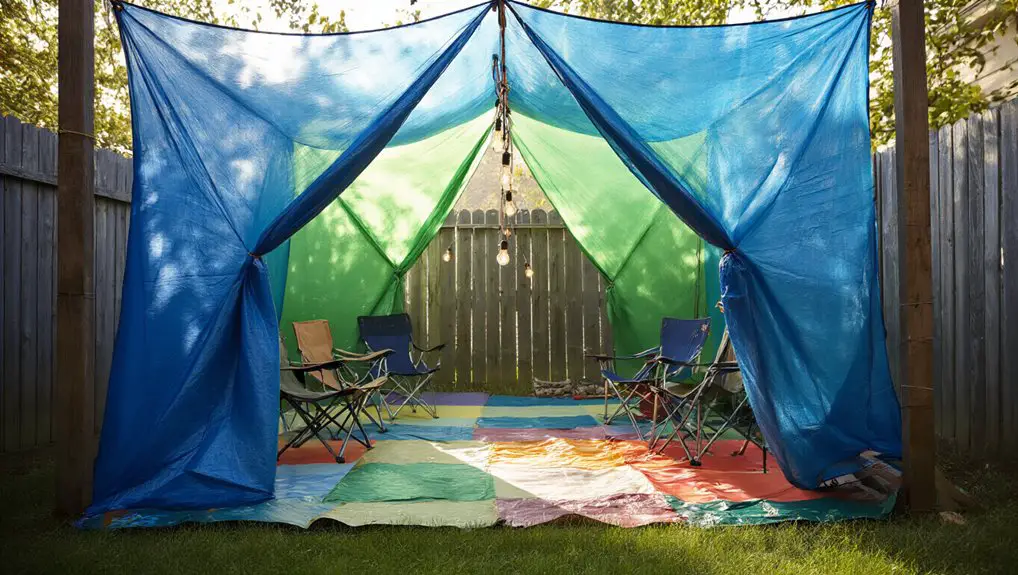I turn cheap tarps and recycled outdoor plastics into practical outdoor solutions like weatherproof tarp forts, planter boxes from buckets, trellises from lattice, and rain chains from bottles. I use simple supports—PVC, reclaimed wood, or conduit—secure grommets with washers and paracord, and slope roofs for drainage so puddles don’t form. I cut taped windows for light and hang string lights through grommets for ambiance. Keep tools basic and adaptable; keep going to see how.
Key Takeaways
- Convert durable polyethylene or canvas tarps into pop-up shelters sized for occupants and yard space.
- Use PVC, reclaimed wood, or conduit to build lightweight frames and reinforced grommet anchors.
- Create planters, trellises, rain chains, and storage bins from recycled outdoor plastics for multiuse spaces.
- Add ventilation and light with cut windows, clear plastic panels, and string lights woven through grommets.
- Maintain slope for drainage, reinforce for snow loads, and clean/store tarps properly for longevity.
I love finding new ways to repurpose outdoor plastics, and I’ll show you practical, low-cost projects that brighten gardens, solve storage problems, and cut waste; think planters from old buckets, trellises from lattice panels, rain chains from recycled bottles, and neat storage bins made from crates—each idea uses common materials, simple tools, and clear steps so you can start transforming scraps into useful, attractive items this weekend.
A tarp fort is one of my favorite quick builds: it’s flexible, weatherproof, and fun for kids or a private reading nook. Start by picking a durable tarp—polyethylene tarps are lightweight and water-resistant, while heavier canvas-backed tarps last longer. I choose a tarp size that matches the space and number of occupants; for two people a 10×10 works well, for a family I go bigger. Consider colors and patterns that blend with your yard or add a pop of contrast.
Next, gather supports. PVC pipes are cheap and easy to cut; you can make a pop-up frame with connectors or fashion A-frame sides. For a sturdier structure, reclaimed wooden posts or conduit pipe work great. I drill holes in corners and run paracord or nylon rope through reinforced grommets, tying to stakes or trees. If your tarp lacks grommets, punch holes with an awl and reinforce with washers so the fabric won’t tear. I always anchor corners and midpoints to prevent flapping in wind—use ground stakes, sandbags, or heavy planters as weights.
Gather sturdy supports—PVC, reclaimed wood, or conduit—reinforce grommets, and firmly anchor tarp corners to prevent flapping.
I think about ventilation and light; cutting windows with a utility knife and hemming edges with duct tape keeps them neat. Clear plastic sheeting from old greenhouse panels can make see-through windows that still block wind. For doors, I hang one side of the tarp with clamps or carabiners so it swings open, then secure the other side with toggles when I want privacy.
Inside, I lay down foam pads or an outdoor rug and add waterproof cushions. String lights woven through grommets create a cozy glow and are practical for evening use.
Tarp forts need drainage—slope the roof so water runs off and don’t let puddles collect. For snow loads, take the tarp down or reinforce with cross-bracing. When the season changes, I clean the tarp with mild soap, dry it, and fold it loosely to avoid creases.
These forts are cheap, adaptable, and teach basic shelter skills while giving you a portable, comfortable outdoor room.
Frequently Asked Questions
Can Tarps Be Recycled After Heavy Use?
Yes — but it’s limited: only about 9% of mixed plastics get properly recycled, so I check material codes and local rules. I’ll clean, trim metal grommets, then drop usable tarp pieces at specialty recycling or repurpose them.
Are Waterproofing Sprays Safe for Food-Contact Surfaces?
No — I wouldn’t use waterproofing sprays on food-contact surfaces; they often contain solvents and PFAS that aren’t food-safe. If you need protection, I’d choose FDA-approved coatings or use physical barriers like food-grade liners instead.
Can a Tarp Fort Withstand High Winds?
No, a simple tarp fort usually can’t withstand high winds; I recommend anchoring with multiple stakes, using rigid supports, low profiles, and windbreaks, and checking forecasts — otherwise I wouldn’t risk it during strong gusts.
What Are Safe Ways to Heat a Tarp Fort?
You can’t use open flames; I stick to battery or propane camp heaters with proper ventilation, use hot-water bottles and insulated sleeping pads, ensure smoke/CO detectors, and keep fabrics away from direct heat to prevent melting or ignition.
Do Any Local Regulations Restrict Outdoor Tarp Structures?
Yes — many places restrict them. I check local zoning, park rules, fire codes and permits, plus HOA covenants. I call city or park officials when unsure, and I avoid blocking paths, utilities or creating fire hazards.

